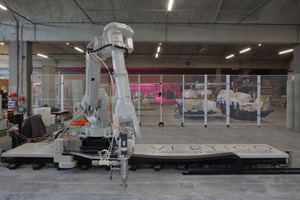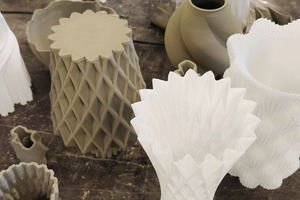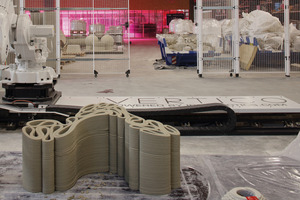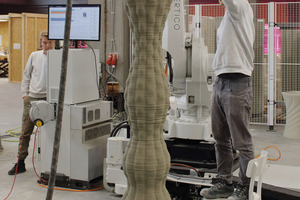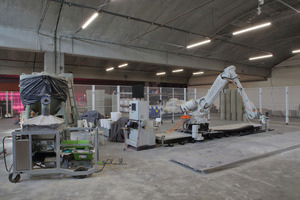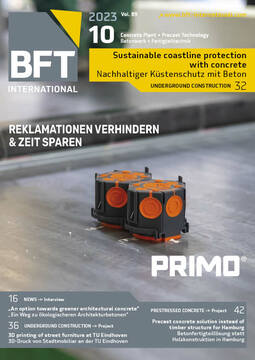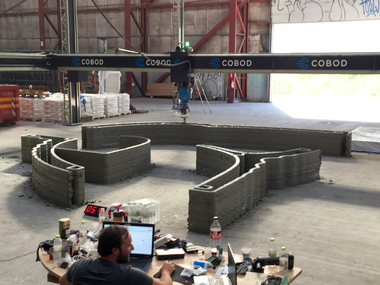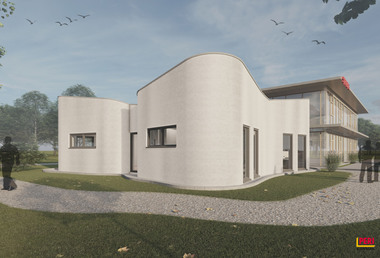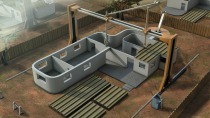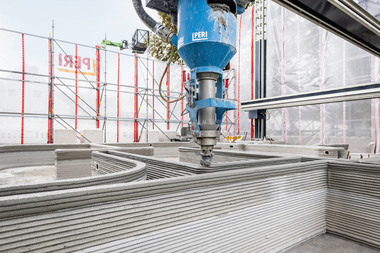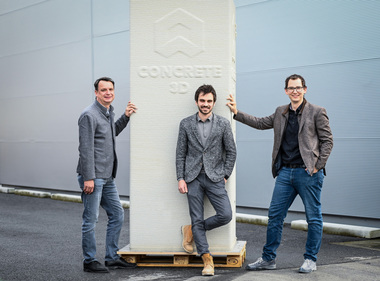3D printing of street furniture at TU Eindhoven
At the Technical University of Eindhoven, Prof. Cristina Nan’s research and teaching activities relate to the 3D printing of concrete, among other subjects. She also deals with the social, societal and sustainability aspects of this relatively new technology. The full article was also published in the Jahrbuch Beton Bauteile 2023 (in German only) available from the Profil bookshop of Bauverlag.
Volker Ruitinga is the owner of Vertico, a company based in the Dutch city of Eindhoven that specializes in the large-scale printing of 3D objects. It is a major service provider in this field to the Technical University of Eindhoven (TU/e), which usually only performs small-scale 3D printing in its laboratories.
Ruitinga’s quality-driven approach combined with his expertise in what “levers to pull” is exactly what Prof. Cristina Nan is keenly interested in as part of her research into 3D printing: What is the human impact on 3D printing? The whole world pretends that all you have to do is have a vision, draw a corresponding plan and perhaps program an algorithm. After that, you can safely sit back because the rest will be done by a robot. But this is not true: Just like in traditional crafts and trades, there are human factors involved in the printing of materials. Experience and intuitive solution strategies employed by the operators are necessary in order to achieve the envisaged result with the equipment used, i.e. the robot.
Example: Slight jerking
Starting on a flat surface, the print head begins to move along a complex trajectory. This repetitive motion sometimes also resembles a circle and is definitely reminiscent of a slot car track on which a lonely race car runs its laps, particularly during the initial part close to the ground. This impression is certainly also supported by a comparable print head speed of about 17 cm/s. During the printing process in the presence of the author, the print head moved about an exceedingly narrow 180° turn in several instances so that the printed strips were located directly next to each other. However, the print head jerked regularly on just a single sweep, but not on all the others. The operator who was asked about this phenomenon explained that at this point the movement of the print head was transferred from one robot arm joint to another.
Usually, a curve motion is predominantly performed by only one joint. In the case at hand, however, the direction of motion was so unfavorable from a mechanical point of view that it resulted in such a shift from one joint to another. The jerk was caused by internal monitoring since the computer control system detected that the arm had moved too far in the wrong direction using the first joint, which is why the impulse was taken back from the joint and another joint was activated instead. This correction took place in the range of a single pixel, i.e. on maximum resolution level, and was thus not detectable on the printed object.
Example: Dynamic mix adjustment
Yet the control options that the technicians have at their disposal relate not only to the robot itself but also to the associated processing equipment, providing an exciting range of features. For example, for printing the “defective” column again, Volker Ruitinga would modify the printing mortar mix on the fly, i.e. during the printing process, to increase the setting agent ratio. Thus, the mortar layers lying vertically on top of each other are initially produced according to the standard recipe, and then the proportion of the additive is increased from the moment the layers begin to project and a certain offset becomes visible. Volker Ruitinga employs this approach to prevent unsightly imperfections in the formation of the layers.
Urban furniture
In the university project for the 2022 summer term, Prof. Nan had her students develop urban furniture. What all the objects have in common is that they should arouse the curiosity of passersby and invite them to come closer, thus automatically creating a place to meet that encourages communication and engagement. At the same time, however, the designs had to be produced using the available 3D printing equipment. This applied both to the possible geometries depending on the material and to the creation of a suitable algorithm. The stop-and-go processes mentioned above, for example, had to be avoided.
Two objects were finally manufactured. First, a component of an additively structured seating landscape was printed. Its elements can be referred to as individual pieces of a puzzle that can be positioned such that they engage with each other. Alternatively, the round recesses can be filled with a flat “plug”, a recessed seat, instead of a connector. Two of these stool-like plugs had already been printed.
Park bench with a swing
The second object can be imagined, metaphorically speaking, as a strip of toothpaste that, when applied to a toothbrush, exhibits a bulge. Federico Chiavegati, a student involved in the design, describes the idea as a synthesis of the concept of concrete as a solid material on the one hand and the perceived fragility of 3D printing on the other. He and his fellow students expressed this solidity in the large shape of a “ribbed concrete sausage.” They hope that this object might one day lie on a lawn and confuse passersby.
This idea goes in the direction of the works of artist Erwin Wurm, who, for example, had attracted a lot of attention with his “Fat House” in 2003. This is a small house whose bulging walls literally spill out from underneath the overstrained roof. The fragile image of 3D printing, on the other hand, is taken into account on the two fronts, which are reminiscent of the section of an orange. There are numerous radial double struts that run straight from the center to the periphery, where they form a jagged partial circle and then merge into another fully straight double line. About a quarter circle is missing from this orange slice figure: This gap provides the space for seating.
Equipment
Vertico uses an ABB robot that can additionally be moved on a rail, which increases its radius of action from about 3.50 m to over 10 m. It would thus be easy to print a prefab wall of about 3.50 m in height and 10 m in length. The concrete print head as such was developed in-house at Vertico. A hose connects it to a digitally controlled mixer in which fresh printing mortar is produced in a continuous process. For this purpose, dry mortar is added from a small silo located directly next to it via a screw, and other additives, such as setting agents, are also added automatically. A vibrator is repeatedly activated to ensure that air can escape from the mix as a result of the shaking effect.
In the urban furniture project, a nozzle with an opening diameter of 18 mm was mounted on the print head. It is suitable for producing concrete layers of between 20 and 40 mm. In the case at hand, the system produced a 26 mm wide mortar strip at an advance rate of exactly 164 mm/s. The print head completed a full circle at the end of which the robot lifted the nozzle by the layer height in order to repeat the movement. In total, the technicians estimated that they probably processed between 600 and 700 kg of dry mortar on the day on which the two urban furniture elements and one column for TU/e were produced.
Human support
Prof. Cristina Nan focuses on the human support activities that continue to be indispensable for 3D printing. For example, three workers must be present for a print run at Vertico: One of them operates the control system, the other is in stand-by mode for last-minute maneuvers at the print nozzle, and the third person keeps an eye on the mixer. This is because the concrete nozzles do not have a closing feature. As soon as the print run is finished, the pump will stop conveying the mortar. However, as a result of the pipe pressure, mortar will still emerge from the front of the nozzle for a certain time thereafter. This material must be collected by an employee using a bucket and a shovel since it should obviously not drip onto the object. Afterwards, it is this employee’s job to completely empty the mortar hose before the material solidifies and, as a matter of course, to clean the mixer.
What is expensive in 3D printing is neither the processed material, which is actually relatively cheap, nor the amortization of the robot. Human labor remains the most expensive component even with this technology because it requires highly specialized and skilled technicians who know what they are doing.

